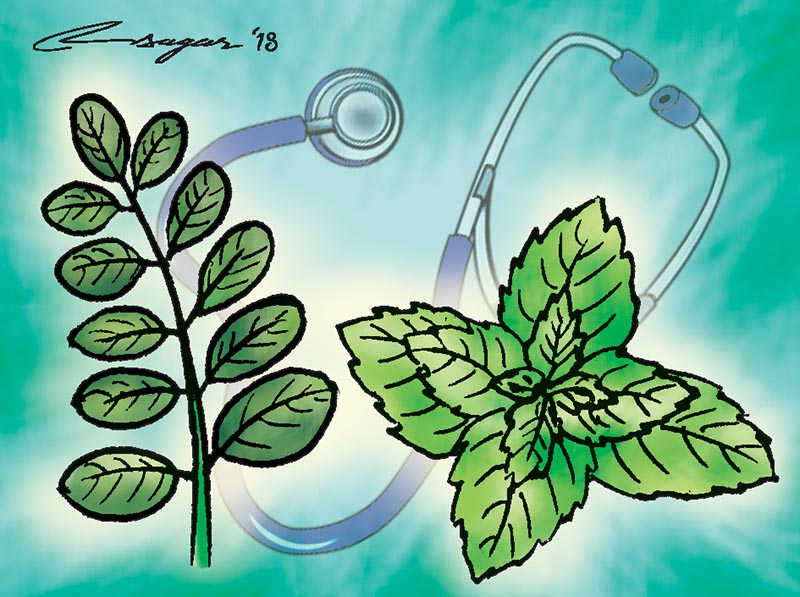Moringa and mint: The magic plants
Both moringa and mint can easily be described as magic plants. But we are yet to bring these magic plants to our kitchens and include them in our daily diet. May be this is the right time to exploit the health benefits of these plants
Moringa and mint are useful plants that can help us get better micro-nutrition. The Food and Agriculture Organisation describes moringa as a very useful plant with a lot of health benefits. Some research articles have shown that moringa is a plant that can help in reducing malnutrition among children and women.
It is found in abundance in Nepal, but we are yet to exploit is medicinal and nutritious value. Moringa is known as sheetal chini or sajiban locally and is mostly used as a vegetable.
When I read about the use of moringa in the African continent, I realised that in our continent we have underestimated the value of this wonderful plant. Moringa is a genus of shrubs and trees with multi-purpose uses. Its leaves, roots and green pods are eaten as a vegetable. Interestingly, all parts of the moringa tree – bark, pods, leaves, nuts, seeds, tubers, roots and flowers – are edible. In many countries, moringa is consumed as a “super food”.
Moringa seed pods are picked when they are still green and can be eaten fresh or cooked. Moringa seed oil is sweet, non-sticking, non-drying and resists rancidity. The seeds can be eaten green or they can be roasted or powdered. The powder can be used in curries or tea.
Some doctors in Nepal have been recommending this plant to their patients informally, even though they do not write it in their prescriptions. Nonetheless, they are learnt to have been providing information on health benefits of this plant and encouraging the patients to use it – not as a medicine but as food.
A research conducted in the USA shows that moringa has two times more protein than plain yoghurt, four times more calcium than milk, 25 times more iron than spinach, four times more Vitamin A than carrots and seven times more Vitamin C than oranges.
Some people who have included moringa in their regular diet have told me that using moringa powder every day has helped them have better sleep and reduced knee pain.
A woman who was suffering from Scleroderma said she started seeing the results within two weeks of using moringa, with the dryness of the skin decreasing substantially.
During a recent discussion on the nutrients that the moringa plant has Dr Rishi Kafle said: “I recommend moringa to my patients. It has a lot of health benefits. Moringa leaves contain Vitamins C and A, calcium and iron. It also contains amino acids (proteins) which are very beneficial for those with constipation problems. Moringa is also rich in antioxidants.”
Dr Kafle, however, says he prescribes moringa not as a medicine but as a food supplement. Our body can absorb nutrients from the moringa plant more easily than from synthetic supplements, says Dr Kafle.
However, according to Dr Kafle, moringa powder should be consumed only after holding proper consultation with health experts, as some people are allergic to it. After my discussion with Dr Kafle, I did some research on the moringa plant only to find that this can be used to combat malnutrition in rural areas.
Maintaining a healthy immune system is essential for helping our bodies fight infections, and this plant has micronutrients that boost our immune system.
Moringa contains antioxidants — flavonoids, polyphenols and ascorbic acid — in its leaves, flowers and seeds. Antioxidants fight free radicals, molecules that cause oxidative stress, cell damage and inflammation. According to a study, leaf extracts have higher antioxidant activity, free-radical-scavenging capacity and higher inhibition of lipid, protein, and DNA oxidation than flowers and seeds.
Along with moringa, the health benefits of mint are also yet to be exploited fully in Nepal. Mint is also a very nutritious plant. We have been using mint at our homes to make chutney for generations. Its leaves can be used fresh or they can be dried to make powder. Mint oil is often used in toothpaste, gum, candy and beauty products. Mint has both antibacterial as well as anti-viral property.
Our ancestors knew that mint is a natural anti-microbial agent and a breath freshener. The mint family refers to a group of around 15 to 20 plant species, including peppermint and spearmint.
I remember my grandmother giving me mint tea on cold days. She also used to make mint sorbet to beat the heat during the summer. So mint makes a good drink round the year. Only in later years, I came to know that mint contains menthol that helps to break up phlegm and mucus. So it clears up congestion of nose, throat and lungs.
We must have seen mint being used as a condiment as well as a decorative item in culinary preparations. Many a chef put a couple of mint leaves on top of their dishes. This not only enhances the aesthetic value of the dish but also adds nutrition to the food.
Mint also helps in digestion and has a natural stimulant which improves our brain activity. Some studies have shown that mint contains certain enzymes that may help prevent and treat cancer. While mint relieves from fatigue and depression, it is also a quick and effective remedy for nausea and headache. It has a cooling and soothing effect.
So both moringa and mint can easily be described as magic plants. But we are yet to bring these magic plants to our kitchens and include them in our daily diet. May be this is the right time to exploit the health benefits of these plants which are easily available around us.






